







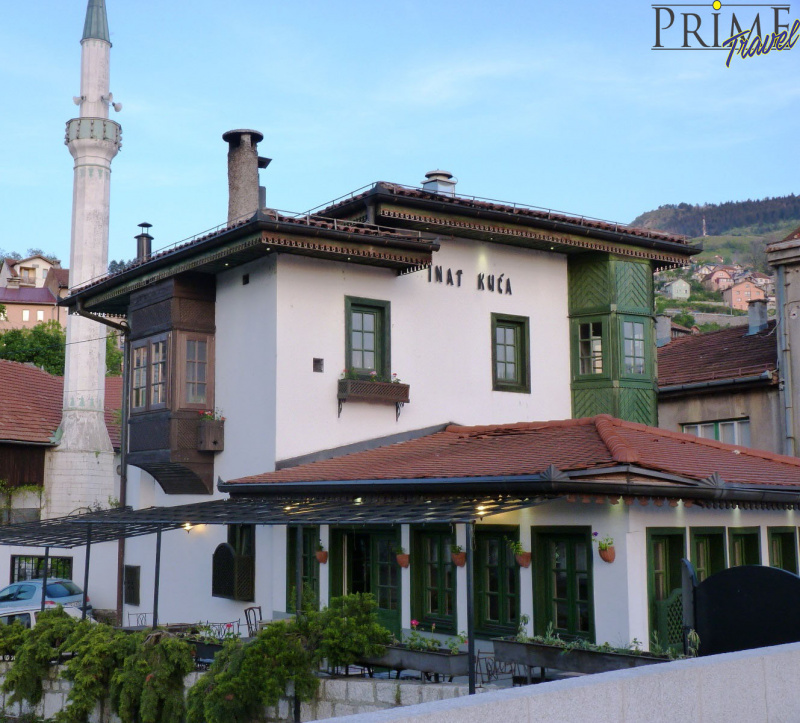
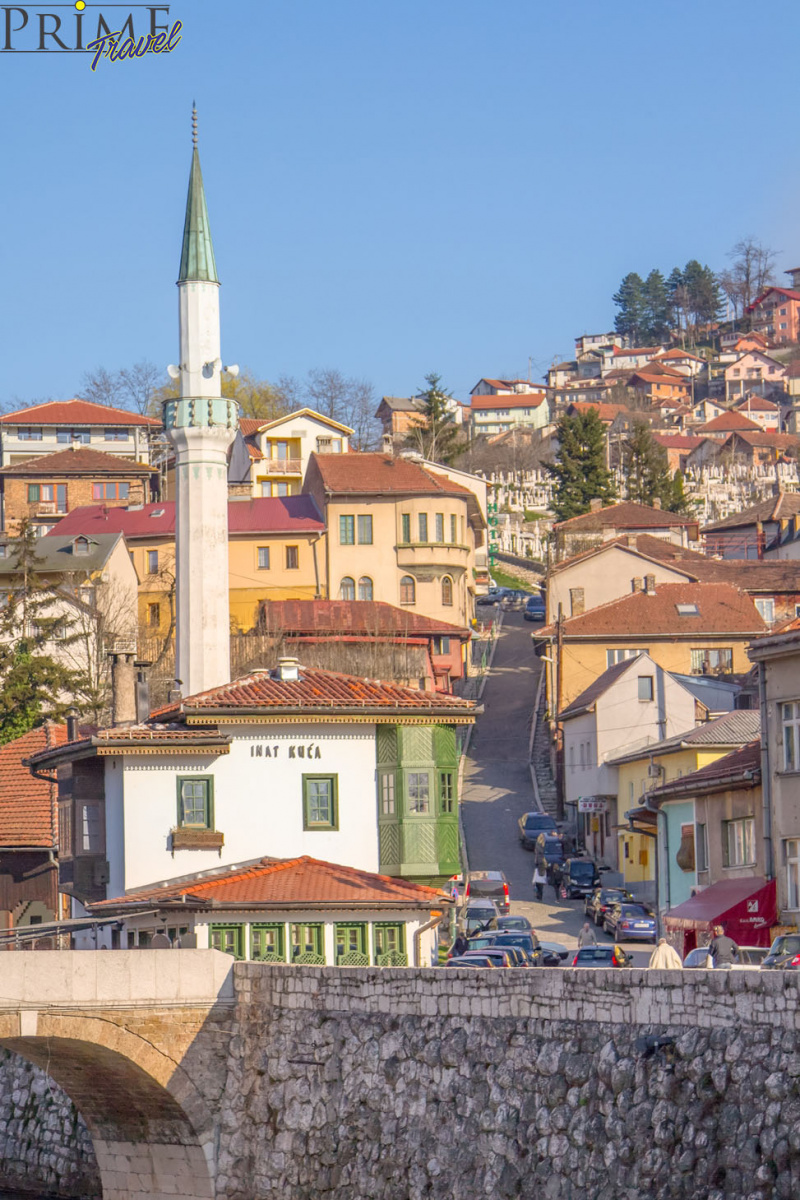












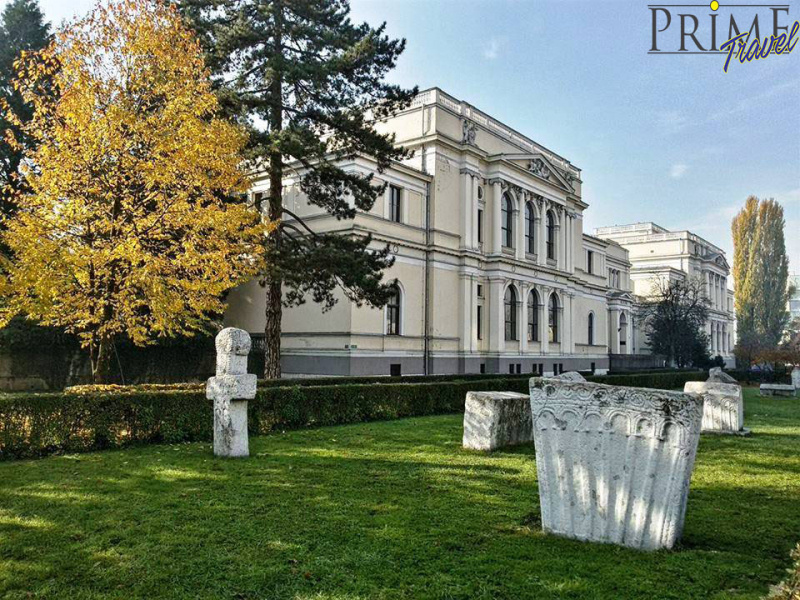









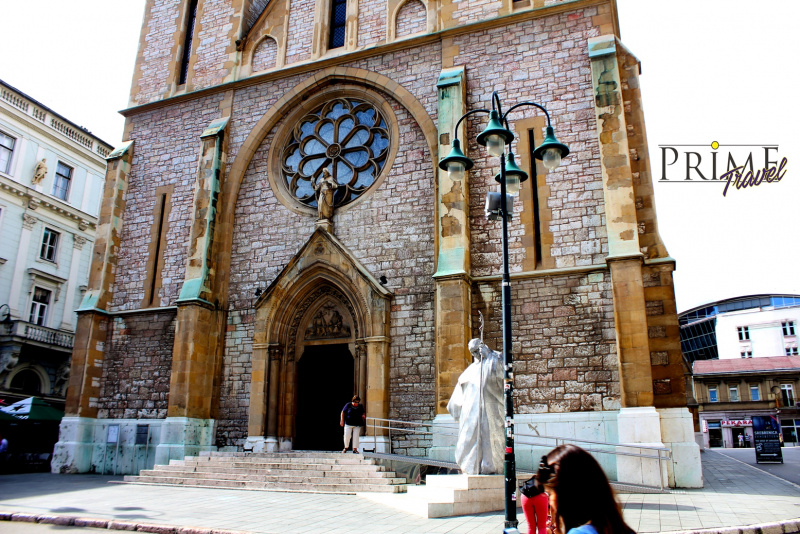



















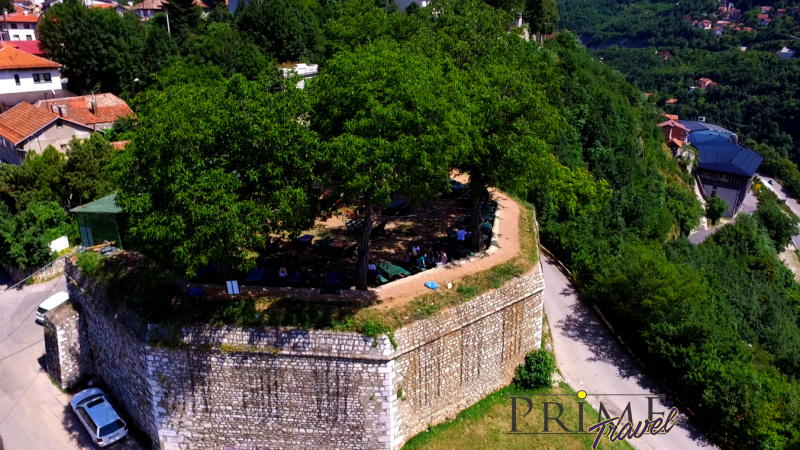



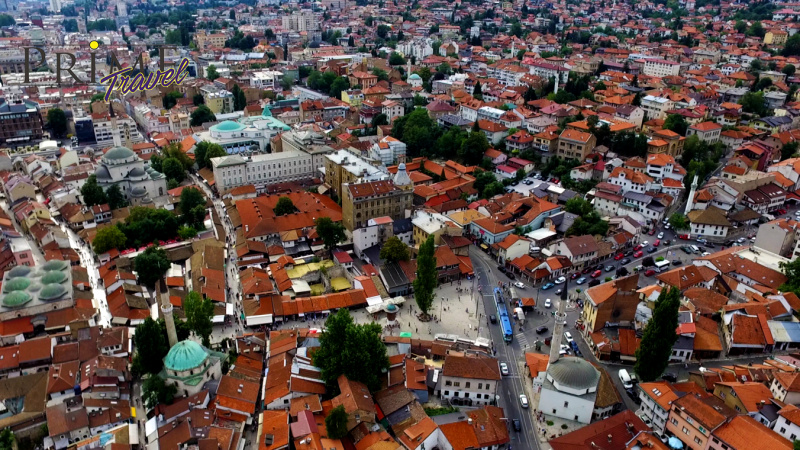
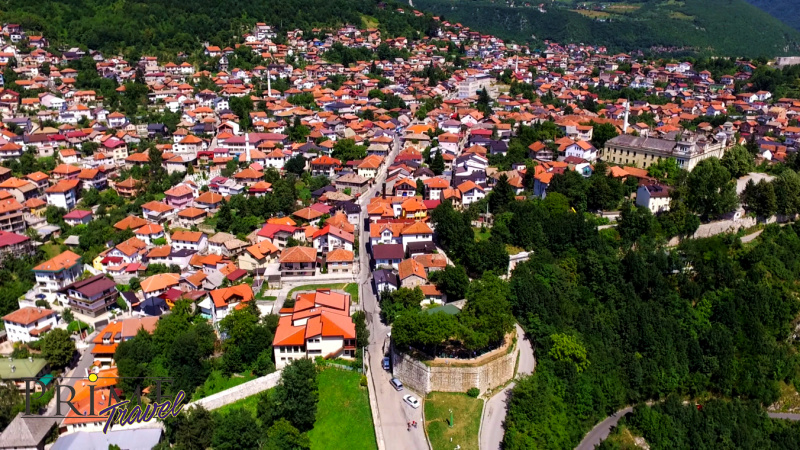


Price: Contact us
Sarajevo is such a city where the strangers also feel like they are at home. Even the expansion of the city by large buildings couldn´t take away the charm of countless cafes and her hospitality tradition. Although the urban background of seemingly endless hills and high mountains isolated in a way the city and preserved the spirit of old times, however he has always kept its doors open to the rest of the world. Regardless to the fact that Sarajevo is the capital city, with the dynamic that everyday life carries it brings a unique atmosphere that simply drawn into your soul. Just a few places in the earth can boast to have a Catholic and Orthodox church, a mosque and a synagogue located only a leisurely walk from each other. If there is a city in Europe that effortlessly straddles east and west, it is Sarajevo.
In Sarajevo, people have time for family and friends. Here it is said that a man's wealth is not measured by what he has, but how many friends he has around him - here people spend their time on building friendship.
Sights you can visit in Sarajevo:
Latin bridge
is one of the oldest bridges of Sarajevo, he changed over time, from the first wooden bridge which stood on the same site to the present form. Otherwise the bridge connected the right bank of Miljacka the part of town where the Christian population lived, who were popularly known as Latinluk, because of this fact the bridge got the name Latin Bridge. Near the bridge in 1914 the assassination of the throne of Austria-Hungary Archduke Franz Ferdinand and his wife Sophie, Duchess of Hohenberg happened, and that day is taken as a cause of World War I. On the bridge they built their statue in their honor, which was demolished in 1918. Parts of the monument are kept in a museum in Sarajevo. In the period between the two world wars, after World War II, until the aggression on Bosnia and Herzegovina, the bridge was named after the young man (Gavril Princip) who assassinated Franz Ferdinand and his wife. In 1995 the bridge got his old name back.
Gazi Husrev-Bey Mosque
Gazi Husrev- Bey Mosque in Sarajevo is due to its size and attractiveness one of the most important monuments of sacred Islamic architecture in the Balkans. It was built in 1530. The mosque was founded by Gazi Husrev Bey. In the shadow of the mosque and the old linden are two tombs, where in 1541 Gazi Husrev-Bey and his prisoner and later his friend Dalmatians Murad Bey Tardić were buried. Not far from the mosque's are the clock tower and Madrasa. In the 16th century, when it was built, Bey's mosque represented an object of great importance for the urban development of Sarajevo and one of the most significant buildings of the rich legacy of Gazi Husrev-Bey.
Gazi Husrev-Bey's Madrasah
is the only school in Bosnia and Herzegovina, and there's not a lot of them in the world, that continuously operate over 470 years. Gazi Husrev-bey´s Madras was founded in the 26th Rajab 943 AH (08th January 1537 in the Gregorian calendar). Its founder, a wise and farsighted Gazi Husrev-bey, is the son of the Bosnian nobleman Ferhat bey. Mother of Gazi Husrev-Bey, Seldzuka, was the daughter of Sultan Bayezid II. Madras was initially called "Seldžukijja", and later will the people known it as "Kursumlija" (because of the roof coated with lead sheath). Naturally gifted, as the children of this region tend to be, Gazi Husrev-Bey was educated in elite schools and hung out with princes. Gained knowledge, demonstrated courage and noble heart enabled him to achieve a successful career as a drain, gain great fame as gazija and left an indelible mark in history as a benefactor: as sandzakbey he ruled Albania, Serbia and Bosnia; as a hero celebrated in Montenegro, Hungary and Croatia, as a benefactor he raised mosque and Tekke, imaret and musafirhana, bridges and han, hamam, fountains and fountains, schools and libraries, and all his goods in Bosnia, Slavonia, Dalmatia and Greece was left for the benefit of the people.
Gazi Husrev-bey´s bezistan
Bezistan is part of the endowment of Gazi Husrev-Bey. It was built in 1555 near the Kuršumli madrassas, Bey's Mosque and the Clock Tower, with which is connected with the eastern entrance. Along bezistan parallel stretches the Gazi Husrev - beys (Goldsmith) Street. Dubrovnik builders helped during his construction. Due to a slightly lower temperature, which is achieved by building below the level of the surrounding streets, the original purpose of bezistan was selling grocery. It still makes a purchase in the warm, summer days, pleasantly.
Clock Tower
is located near Gazi Husrev-bey mosque and is one of the largest in Bosnia and Herzegovina. It was built in the 17th century . Tower builder is Gazi Husrev Bey, one of Bosnia's greatest benefactors from the Ottoman era. The first written record of it dates back to the 17th century. The tower has 76 wooden steps, arranged in a square series, where the Muvekit climbs once a week to set the time. The clock must be set, because it shows the time a la Turca (lunar hour). It is assumed that it is the only one in the world that shows the time by the lunar calendar. This clock shows noon exactly at the moment of sunset in Sarajevo. When during the Islamic holy fasting month of Ramadan, the tower clock strikes 24 hours, than its iftar time. After the first beats on the Bey mosque lamps pale and then on the White bastion traditional shot gun, which marks the end of fasting.
White mosque
White Mosque is located on Vratnik, right next to the devastated Jajce barrack. This is one of the oldest mosques in Sarajevo. It was built by Divan Hajdar Kjatib, the secretary of Gazi Husrev-Bey, after 1536 and before 1545, modeled based on the Bey's Mosque. Alongside the mosque were built maktab and clock tower, which were destroyed during the Austro-Hungarian rule.
Emperor's mosque
is one of the first mosques built in Bosnia and Herzegovina and the first one in Sarajevo. It was built in 1462 and its construction was financed and enabled by the founder of Sarajevo Isa Beg Isakovic. This mosque was burned down in 1480 when the despot Vuk Grgurević broke in with his army from Jajce and burnt Sarajevo. In the same place they built again a mosque and in its present form it was built in 1566, its construction was funded by Suleiman the Magnificent. Octagonal minaret, whose šerefe covered with stalactites, is one of the most beautiful minarets in Bosnia and Herzegovina.
Inat house
This house has made history and became one of the legends in Sarajevo during the Austro-Hungarian Empire at the end of the 20th century, during the construction of the City Hall it should be demolished, but because of the objection of the owner she was moved to the other side of the river.
Bascarsija mosque
or mosque Havadza Durak is located in Bascarsija in Sarajevo. The interior of the mosque is characterized by the excellent solution of brightness daylight and very good acoustics. The mosque was declared as a national monument of Bosnia and Herzegovina in 2006.
City Hall
City Hall is located in Sarajevo, close to Bascarsija on Mustaj pasha mejdan and represents the most beautiful and the most representative building from Austro-Hungarian period. In this style the most of the facilities which were in Sarajevo left by Austro-Hungarian authorities were made, City Hall is a synonym for the Austro-Hungarian period in Bosnia and Herzegovina and the trademark of the time. The first project was made by Karl Parzik, but the minister Benjamin Kalaj didn´t like it because of that the project was entrusted to Alexander Wittek. The mosque Kemal II was a role model in the development of this project, he went twice to Cairo to see the mosque. The building of City Hall was officially put in operation in 1896.
Cathedral Church of the Nativity of the Theotokos
is one of the biggest Serbian Orthodox churches on the Balkan Peninsula. Located in the center of Sarajevo. The decision to build the Orthodox Cathedral of the Nativity of the Theotokos in Sarajevo was made in early 1859. At the insistence of other countries, the equality of Muslims and Christians in Bosnia and Herzegovina were recognized. This meant in practice that it was allowed the masonry of new and reconstruction of old churches, as well as the opening of schools. It was built by the voluntary contributions that were collected from 1863 to the end of construction. Donations were given from the Orthodox Serbs from Sarajevo, the surrounding villages, merchants from Belgrade, Dubrovnik, Vienna and Trieste. According to one source the contribution of 556 ducats gave Sultan Abdul Aziz, who also issued a permit for the construction of the temple.
Sacred Heart Cathedral
is a Roman Catholic cathedral in Sarajevo built in 1889. The project for the construction of the Cathedral was drafted by Josip Vancas combining elements of Romanesque and Gothic and creating a synthesis that distinguishes this church from the others of its kind. After the project is done one part of the interior. Construction of the facility began in 1884, and in 1889 the building was completed and handed over to the Sarajevo City Municipality. The cathedral was built on the site of the former Janissary camp where the Austro-Hungarian administration intended to build a city market. The square in front of the cathedral bears the name of Fr. Grga Martic, and on it is built the memorial to Pope John Paul II, who visited Sarajevo in 1997.
National Museum of Bosnia and Herzegovina
In Sarajevo is the oldest museum in Bosnia and Herzegovina, established in 1888, during the Austro-Hungarian rule. Architect Charles Parzik did a project for the building of the museum, which consists four separate pavilions linked by terraces, with na internal atrium where the botanical garden is. The National Museum in Sarajevo during its nearly a century of existence managed to collect a good deal of cultural and national heritage of the country and all its people. The exhibits are sorted by departments in several different collections, and the most important museum piece is the famous Sarajevo Haggadah, the traditional jewish book, brought by the Jews in Sarajevo after their exile from Spain.
Ashkenazi Synagogue
Ashkenazi synagogue was built in 1902 by architect Karl Paržik in pseudo-Moorish style. It is located along the left bank of the river Miljacka. Today this is the only synagogue in Sarajevo which regularly held religious ceremonies.
Jewish cemetery with a chapel
The cemetery was established along the medieval necropolis of tombstones at Borak with the old quarry on Satoriji, from which were extracted stones used to create medieval and Jewish tombstones. Sephardim created unique tombstones in this area, which by their domomorfnim forms and symbolic motifs make them among all Jewish monuments anywhere in the world unique. The cemetery contains also the cemetery chapel, memorial ossuary from 1952., a monument to victims of Ustasha terror, Ashkenazi ossuary from 1962, a mausoleum with the Ashkenazi ossuary, fountain and fence. All together as the cemetery ground was declared as a National Monument of Bosnia and Herzegovina on 2 September 2004.
The oldest preserved tombstone in this cemetery belongs to the first Sarajevo rabbi. On the tombstone chest is written:
Samuel Baruch, 1630-1650. The tombstone of the righteous.
It was founded in 1620 and the oldest preserved monument is from the first half of the 17th century. This cemetery is claimed to be the most beautiful Jewish cemetery in Europe, because the tombstones are shaped like rounded sarcophagi, based on the shape the cemetery is known as unique in the Jewish world.
Sarajevo Tunnel
The only way to get out from besieged Sarajevo to the free territory was to run across the airport runway. The difficult situation and the blockade of the city led to the idea of building an underground road under the runway. In late 1992, General Rashid Zorlak hired two engineers, Fadil Seru and Nedzad Brankovic, to make a project for the construction of the Tunnel. Starting points in Dobrinja and Butmir were determined, the project for the construction was completed in January 1993. After further commands, the digging continued with all available capacities. At the end of April started the digging from the direction of Butmir. Meanwhile the aggressor found out about the digging, so the work were hampered by the constant bombard. Despite all the difficulties the idea of a tunnel encountered,as well as the digging of the tunnel, on the 30. 7. 1993 around 21 hours, two men digging with two different sides were able to join hands under the Sarajevo airport. That day Sarajevo got a small but safe passage to Butmir, Igman and other free territory of BiH. At the very beginning of the tunnel everything was carried on their back and in their hands. Food, cigarettes, oil, ammunition, weapons, drugs, or the wounded were transferred. Subsequently a stripe was set, so the transportation is facilitated by using small wagons. The surviving part of the tunnel, as well as exhibits in the accompanying museum preserve the memory of the courage of the citizens of Sarajevo and their struggle for survival.
Sarajevo National Theatre
Is the biggest theater house in Bosnia and Herzegovina and one of the most important in South-East Europe. It opened on 17 November 1921, a solemn opening belonged to Branislav Nušić head of the Art Department of the Ministry of Education. Three nights in a row music and drama programs were performed, and so was the start of the Theatre marked. In the beginning of its existence, Sarajevo National Theatre operated exclusively as a drama theater. Since 1946 in this theater are also introduced music forms of action, so will Opera or Ballet contribute to the rich history of this theater. Sarajevo National Theatre is the central theater house of the BH State and with his artistic results, the work of generations of artists, especially the type of organization (three ensembles Opera, Drama and Ballet), is considered as an very important element of theater and even spiritual life in BiH.
Eternal Flame
Eternal Flame is a monument to military and civilian victims of the Second World War in Sarajevo. The monument was made on 6 April 1946 on the first anniversary of the liberation of Sarajevo from German occupation. The monument is located in the city center, between Marshal Tito and Ferhadija street. During the siege of Sarajevo, the flame at the monument was shut down because the city lacked fuel.
The text written on the wall:
With Courage and the Jointly Spilled
Blood of the Fighters of the Bosnian-Herzegovinian,
Croatian, Montenegrin, and Serbian Brigades
of the Glorious Yugoslav National Army; with
the Joint Efforts and Sacrifices of Sarajevan Patriots
Serbs, Muslims and Croats on the 6th of April 1945
Sarajevo, the Capital City of the People's Republic
of Bosnia and Herzegovina was liberated.
Eternal Glory and Gratitude to the Fallen Heroes
of the liberation of Sarajevo and our Homeland,
On the First Anniversary of its Liberation--
a Grateful Sarajevo
Goat's Bridge
Goat's Bridge is located in the canyon of the river Miljacka, a few kilometers east of the old city center of Sarajevo. The road on which he crossed the river is the famous Istanbul road, that is the way that, at the time of the Ottoman Empire, from Sarajevo went to the eastern parts of the Empire, all the way to Istanbul. Goat´s Bridge is one of four bridges in the City which are still preserved. The other three bridges are Seher-Cehaja bridge, Latin bridge and Roman bridge.
Sebilj
Sebilj or Sebil is an Arabic word which means "road", but the term defines a very old charity institution, fountain with a special shape on to the streets, where the Sebilj man pulled the water from sinks out and gave it for free to the thirsty ones. Sebilj in Bascarsija is the only facility of its kind in Sarajevo, constructed in 1891 by the Czech architect Alexander Vitek. Sebilj, which was raised in 1754 by the Bosnian vizier Mehmed-pasha Kukavica, was burned in a fire in 1852, but was a bit lower set than today's.
Vrelo Bosne (Public park)
Vrelo Bosne is a source in central Bosnia and Herzegovina. It´s a source of the river Bosna, and one of the most famous features of Bosnia and Herzegovina. Vrelo Bosne is on the outskirts of Sarajevo, next to Ilidza. One of the most famous scenes of natural beauty in the region, located in the metro area of Sarajevo. Today is the Vrelo Bosne known as a tourist attraction for foreign tourists and the nearby visitors who want to enjoy nature. It is consists of several small islands linked by bridges over the numerous smaller streams. Enough animals are found in the park, such as ducks and swans. There are also other attractions in the park, such as carriages, places to hike and restaurants.
White bastion
Is the tower on the road Dariva - Moscanica, on the eastern peak elevation of Sarajevo valley. It was built on the site of a medieval fortress, built around 1550. The upper part of the bastions in huge stone blocks was built in the Austro-Hungarian period. The tower was of great importance for the defense of the city during the attack of the Austrian Prince Eugene of Savoy in the 17th century, and the Austro-Hungarian army in 1878. White bastion was declared as a National Monument of Bosnia and Herzegovina.
Yellow bastion
Climbing the old town leads to a small fortress "Yellow bastion," a unique experience in the panoramic view, sight and sound. On the north side there are stairs and a facility for soldiers, and on the southwest side is the Muslim cemetery. Although the Austro-Hungarian army continues to benefit from Yellow bastion, Muslims are still allowed to fire the cannon during Ramadan, as a sign of the end of fasting. This practice is prohibited for a period of Yugoslavia, but was restored in 1992 and continues to this day.
The archaeological site "At Mejdan" and Bakr- Baba mosque
is located on the left bank of the Miljacka River near the bridge Ćumurija, are the remains Bakr - babine mosques, madrassas, mekteb and harem. The mosque and mekteb of waqf Ali Bakr-Babe,was built in the mid 16th century. Over time around the mosque was built a significant educational and cultural center, which consisted of boyish mektebs, Misirijine madrassas and Kantamirija library. At the end of the 19th century the mosque was destroyed, and shortly after that and the surrounding educational facilities.
Taslihan
is a stone han built with bezistan in the 16th century. It was founded by Gazi Husrev-Bey. It was built by Dubrovnik builders. In addition to being used as a shelter it was also used as a trade place.
Music Pavilion in Sarajevo
was built in 1913, a project for the construction was made by Joseph Pospisil. It was built in an area that several times has changed its name and function in history. In this area in the 17th century there was a hippodrome (therefore the name Atmejdan), which in 1878 turned into Filipovic's market, and then in 1905 was converted into a park of Franz Joseph. In former Yugoslavia, it was called the Park of King Dusan, and today bears its original name Atmejdan.